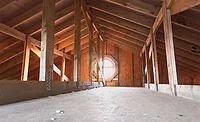Ice Dams: Educating Homeowners About the Dangers and Solutions
Every winter the threat of ice dams rears its ugly head. Ice dams hide potential problems that are unknown to most homeowners and often present an opportunity for roofing contractors to educate homeowners about the dangers that lie beneath the glistening icicles.

Every winter the threat of ice dams rears its ugly head. Ice dams hide potential problems that are unknown to most homeowners and often present an opportunity for roofing contractors to educate homeowners about the dangers that lie beneath the glistening icicles.
Today’s homeowners are smarter than ever, yet ice dams remain among the least understood - and most damaging - problems a home can have. The winter months give you the opportunity to spend more time with homeowners and educate them about the complexities of their home and how the freezing and thawing process affects their roofs.
Ice dams, as you know, are usually a symptom of a defective or poorly designed roof system. Unless properly remedied, ice dams can lead to structural damage in the roof and home, poor indoor air quality, energy loss and unsafe conditions for homeowners. But there is a good chance that homeowners are unaware of the dangers and potentially expensive problems associated with ice dams. At the very least, they are most likely unaware of the causes of ice dams, and they may not think they pose a problem at all.
This presents you, the roofing contractor, with the opportunity to educate homeowners, offer short-term solutions that could delay expensive repairs, and discuss long-term solutions for repairing the roof in the spring.

• Gutters are not the problem. The most important thing you can help homeowners understand is that gutters are not the issue; ventilation and insulation - or lack thereof - are the problem. Ice dams occur when heat escapes from the living space to the attic and becomes trapped there. As the attic air warms, it causes snow on the roof to melt. The melted snow then re-freezes on the eaves, resulting in a buildup of ice and the telltale icicles. Uneven distribution of snow on the roof and little to no snow at the peak are other warning signs.
• Quick fixes are not the answer. Homeowners may be tempted to opt for quick fixes, such as installing heat coils on the eaves, or “raking” the roof. While these may reduce icicle formation, they do not address the root cause of the problem, and the homeowner may still face expensive repairs in the future. In fact, the longer a problem is put off, the more it may cost to fix when the time finally comes.
• Ice dams are a sign of big problems. Above all else, you should also tell homeowners about the larger problems that ice dams might represent. Knowing the dangers of ice dams helps motivate them to take action.
As their name implies, ice dams prevent water from draining properly. This may often cause water to back up underneath the shingles and seep into the home, which can lead to a host of problems. Water damage to drywall and woodwork, rot and structural damage to the frame, warping of the roof deck, and reducing the life of the shingles are just a few of the problems that can result from ice damming. Water inside the home can also lead to mold growth, which can affect indoor air quality and the “health” of the roof system.
Those are all hidden dangers, which may not be apparent until it’s too late. But there are also other dangers that are easy to see. Heavy icicles hanging over doorways can be very dangerous when they fall, and ice accumulating on walkways makes for very treacherous footing.
Additionally, ice dams are nearly always a sign that the home is wasting energy. With the cost of energy continuing to rise, homeowners are usually open to ideas that save them money.
Despite the evidence, homeowners may still be leery of the costs involved with fixing the problems. Offer guidance about the benefits of fixing the problem, and short- and long-term solutions. Though roof repairs may be expensive, they are a bargain compared to replacing rotted rafters or eradicating mold. And the repairs will help reduce energy costs and extended life of shingles and other roofing materials.

1. Increase attic insulation. Inadequate insulation is a common problem, but it’s also the easiest to remedy. Adding insulation, particularly around recessed lights and other openings, will effectively slow the movement of heated air into the attic. Be sure to check with your local codes on the required or recommended amount of attic insulation.
2. Redesign the ventilation system. A well-ventilated attic allows fresh air into the attic and exhausts stale, moist air. Fixing this problem may be as simple as making sure all vents are working properly and not clogged with debris. If a redesign of the ventilation system is in order, that is likely something that will need to be done in spring as part of a re-roofing project.
3. Install ice and water barriers. If you eventually do replace the roof, be sure to install barriers on the eaves and valleys. The newest available products are self-adhesive membranes that seal directly to the deck and even around nails. Installing these at least 24 inches past the inside wall, and in the valleys, offers protection if ice dams do occur, as they help prevent water from entering the home.
By taking the approach of guiding and helping homeowners to see the damage ice dams can cause - and the money they’ll save by addressing the problems - you are likely to win their confidence and trust.

Every winter the threat of ice dams rears its ugly head. Ice dams hide potential problems that are unknown to most homeowners and often present an opportunity for roofing contractors to educate homeowners about the dangers that lie beneath the glistening icicles.
Today’s homeowners are smarter than ever, yet ice dams remain among the least understood - and most damaging - problems a home can have. The winter months give you the opportunity to spend more time with homeowners and educate them about the complexities of their home and how the freezing and thawing process affects their roofs.
Ice dams, as you know, are usually a symptom of a defective or poorly designed roof system. Unless properly remedied, ice dams can lead to structural damage in the roof and home, poor indoor air quality, energy loss and unsafe conditions for homeowners. But there is a good chance that homeowners are unaware of the dangers and potentially expensive problems associated with ice dams. At the very least, they are most likely unaware of the causes of ice dams, and they may not think they pose a problem at all.
This presents you, the roofing contractor, with the opportunity to educate homeowners, offer short-term solutions that could delay expensive repairs, and discuss long-term solutions for repairing the roof in the spring.

Educating Homeowners
As a professional contractor, you know that ice dams are not a problem with the gutters. However, many homeowners assume that ice dams form when gutters and downspouts are clogged, causing water and ice backs up onto the roof. They may also assume that ice dams are just a fact of life in winter, an unfixable problem, or not a problem at all.• Gutters are not the problem. The most important thing you can help homeowners understand is that gutters are not the issue; ventilation and insulation - or lack thereof - are the problem. Ice dams occur when heat escapes from the living space to the attic and becomes trapped there. As the attic air warms, it causes snow on the roof to melt. The melted snow then re-freezes on the eaves, resulting in a buildup of ice and the telltale icicles. Uneven distribution of snow on the roof and little to no snow at the peak are other warning signs.
• Quick fixes are not the answer. Homeowners may be tempted to opt for quick fixes, such as installing heat coils on the eaves, or “raking” the roof. While these may reduce icicle formation, they do not address the root cause of the problem, and the homeowner may still face expensive repairs in the future. In fact, the longer a problem is put off, the more it may cost to fix when the time finally comes.
• Ice dams are a sign of big problems. Above all else, you should also tell homeowners about the larger problems that ice dams might represent. Knowing the dangers of ice dams helps motivate them to take action.
As their name implies, ice dams prevent water from draining properly. This may often cause water to back up underneath the shingles and seep into the home, which can lead to a host of problems. Water damage to drywall and woodwork, rot and structural damage to the frame, warping of the roof deck, and reducing the life of the shingles are just a few of the problems that can result from ice damming. Water inside the home can also lead to mold growth, which can affect indoor air quality and the “health” of the roof system.
Those are all hidden dangers, which may not be apparent until it’s too late. But there are also other dangers that are easy to see. Heavy icicles hanging over doorways can be very dangerous when they fall, and ice accumulating on walkways makes for very treacherous footing.
Additionally, ice dams are nearly always a sign that the home is wasting energy. With the cost of energy continuing to rise, homeowners are usually open to ideas that save them money.
Despite the evidence, homeowners may still be leery of the costs involved with fixing the problems. Offer guidance about the benefits of fixing the problem, and short- and long-term solutions. Though roof repairs may be expensive, they are a bargain compared to replacing rotted rafters or eradicating mold. And the repairs will help reduce energy costs and extended life of shingles and other roofing materials.

Offering Solutions
The first step is an inspection of the roof an attic, which will most likely reveal the problem. After that, you can discuss these solutions with the homeowner:1. Increase attic insulation. Inadequate insulation is a common problem, but it’s also the easiest to remedy. Adding insulation, particularly around recessed lights and other openings, will effectively slow the movement of heated air into the attic. Be sure to check with your local codes on the required or recommended amount of attic insulation.
2. Redesign the ventilation system. A well-ventilated attic allows fresh air into the attic and exhausts stale, moist air. Fixing this problem may be as simple as making sure all vents are working properly and not clogged with debris. If a redesign of the ventilation system is in order, that is likely something that will need to be done in spring as part of a re-roofing project.
3. Install ice and water barriers. If you eventually do replace the roof, be sure to install barriers on the eaves and valleys. The newest available products are self-adhesive membranes that seal directly to the deck and even around nails. Installing these at least 24 inches past the inside wall, and in the valleys, offers protection if ice dams do occur, as they help prevent water from entering the home.
By taking the approach of guiding and helping homeowners to see the damage ice dams can cause - and the money they’ll save by addressing the problems - you are likely to win their confidence and trust.
Looking for a reprint of this article?
From high-res PDFs to custom plaques, order your copy today!





